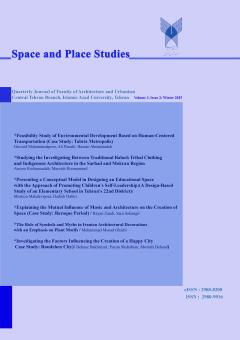Studying the Investigating Between Traditional Baloch Tribal Clothing and Indigenous Architecture in the Sarhad and Mokran Region
Subject Areas : Architecture
arezou rostamzadeh
1
![]() ,
Marziyeh Hoomani Rad
2
*
,
Marziyeh Hoomani Rad
2
*
![]()
1 -
2 - استاد
Keywords: Native Architecture of Sistan and Balochestan, Needlework Techniques and Motifs, Climate, Sustainable Architecture, Sistan and Baluchestan,
Abstract :
This study examines the interaction between traditional dress and indigenous architecture in the Sistan, Sarhad, and Makran regions of Iran, and the mutual influence of these elements throughout history. The research uses library and scientific resources along with an interpretive and analytical method to explore the symbolism of geometric patterns in Baluchi embroidery and its connection with indigenous architecture. The aim of the study is to investigate the mutual influence of the principles of indigenous architecture in Sistan on the traditional dress of its native peoples. Based on this objective, the role of four fundamental factors—"geography, culture, architecture, and history"—in the emergence of various traditional costumes in Sistan and their impact on the structural patterns of the remaining historical buildings in the region are examined. The results show that the most significant factors influencing the form, texture, and design of the traditional dress in Sistan and Baluchestan, in order of priority, are natural geography and culture. Cultural geography and historical architecture follow these two factors in shaping both architecture and dress. The role of decoration in the aesthetic creation of the architecture of the Baluchi people, often combined with finer decorations, is also noted.
Investigating the Interaction Between Traditional Clothing of Iranian Tribes and Indigenous Architecture
Case Study: Sarhad and Makran Region (Sistan and Baluchestan)
اسفندیاری،ص.(1370)، نگرشی بر روند سوزن دوزی های سنتی ایران، تهران: صبا.
بختیاری، آ. (1400)، طراحی لباس فاخر بانوان با استفاده از الگوهای هندسه فرکتال در آینهکاری ایرانی(مورد مطالعاتی:کاخ گلستان ،دانشگاه هنر تهران.
بی باک، غ ر، افتاده،م. (1395)، عوامل تاثیر گذار در به وجود آمدن نقوش سوزن دوزی بلوچ،نخستین همایش رودوزی های سنتی سیستان و بلوچستان، زاهدان.
جانب اللهی ، م .س. (1378)، بازشناسی در مسکن روستایی. مجلۀ آبادیش، ۶۰، پاییز ۲۶ - ۳۳.
خدا بنده لو ، ز. خرمشاهی،م. (1387)، مسکن سنتی بلوچ.مجله تحقیقات جغرافیایی. 43. 92-118.
خاموشی ،ز. (1387)، تحول کاربرد و تزیین در سوزن دوزی بلوچ و ترکمن به شیوه سنتی و مدرن، مطالعات هنر اسلامی،موسسه مطالعات هنر اسلامی،شماره9، صص73-98.
ریگی ،ز. (1395)، تاریخچه نقوش سوزن دوزی زنان بلوچ، نخستین همایش رودوزی های سنتی سیستان و بلوچستان، زاهدان.
سوزان ،ح. (1399) مطالعه تطبیقی بازتاب مؤلفه های سنتی معماری در آثار منیرشاهرودی فرمانفرماییان و سـوزان حفونه. مطالعات هنرهای زیبا.
سنجربیگی، ل . (1397)، طراحی خانه مد و لباس با رویکرد ترویج فرهنگ ایرانی- اسلامی (نمونه موردی: طراحی خانه مد و لباس در شهر تهران، موسسه آموزش عالی باختر ایلام، دانشکده فنی و مهندسی.
طاهر عزیزی، م، شیخی، ع. (۱۴۰۰)، گونهشناسی و تحلیل نقوش قوم بلوچ در بلوچی دوزی سرحد و مکران. ره پویه هنر، ۱۳۷۴، ۶۹-۷۴.
کشاورز،گ، جوادی،ش.(۱۳۹۷)، انتزاع نمادین در زیباییشناسی هنر بلوچستان، نمونۀ موردی: سوزندوزی بلوچ. نشریه علمی پژوهشکده هنر، معماری و شهرسازی باغ نظر، ۱۶(۷۹).
مولایی، ص.، سلیمانی، س. (۱۳۹۳). عناصر باارزش معماری بومی منطقه سیستان بر مبنای مؤلفههای اقلیمی معماری پایدار.
نظریان، ا.، میربهائی، م. (۱۳۸۹). نقش ساختار قومی در دوقطبی شدن مراکز تجاری (بازار شهر زاهدان).

